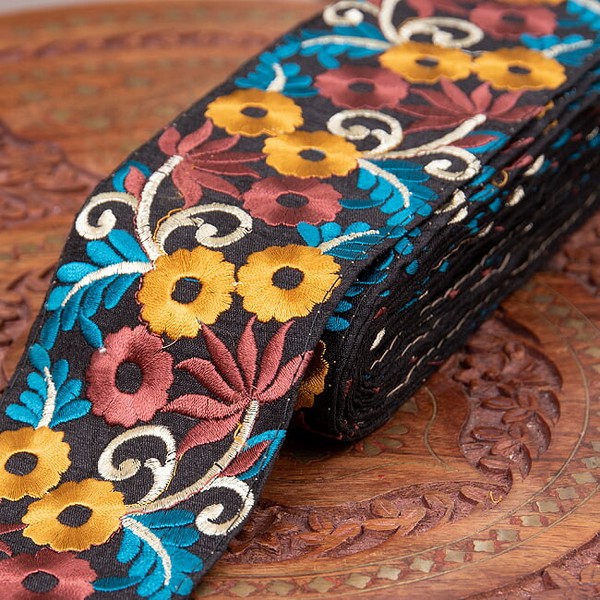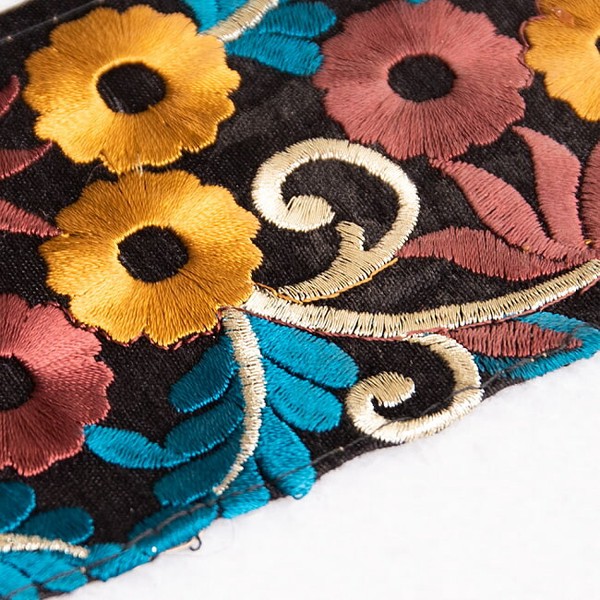


Vendor Profile
TIRAKITA CO., LTD.
| Address | 339 Isshiki Hayama-machi Miura-gun Kanagawa, JAPAN ZIP:238-0026 |
|---|---|
| Representative Name | Atsushi Umehara |
| Annual Revenue | closed |
| No. of Employees | closed |
| Web Site URL |








Other items from this category
SD item code:12334140
| Detail | Price & Quantity | ||
|---|---|---|---|
| S1 |
[extra thick width 7.5cm] Tyrolean tape - sold by meter - Masashi
【極太幅7.5cm】 チロリアンテープ-メーター売 - 雅
(ID-CIROLTAPE-858#6)
|
(ID-CIROLTAPE-858#6)
Wholesale Price: Members Only
6 pcs /set
In Stock
|
|
| Dimensions |
|---|
|
Tape width: 7.5cm
|
| Specifications |
|---|
|
Country of manufacture: India
Material / component: Synthetic fibers (some parts are made of cotton, but the main part is synthetic fibers)
Package: Identical to photo
Year of manufacture: 2021
Product tag: None
|
Description
| *Indian Tyrolean Tape Indians use it by sewing it on the bottom part of the sari, the part that touches the ground, so that the sari looks more beautiful and the sari does not become tattered. [Tyrolean" is originally derived from a European regional name, but in India it has developed in its own unique way especially for decorating saris and other garments. *Beautiful embroidery. Tyrolean tapes are very gorgeous, with three-dimensional embroidery using golden threads and shiny, colorful fabrics. It is an unusual tape with a wonderful presence unique to India! Just sewing a little bit of it on something will make it look bright and gorgeous ^^. It is also great for sewing on to the hem of jeans or skirts, or for beautifully tailoring bags, curtains, etc.! Even a simple outfit or bag can be given an Asian touch with just a few simple touches. It is up to you how you use it, so why don't you use it in various places to make your fashion and your room more ethnic? *History of Indian Embroidery The tradition of embroidery in India dates back to 2300 - 1500 BC. Bronze needles have been excavated at the ruins of Mohenjo-daro, a city of the Indus civilization (2500 B.C. - 1800 B.C.). Embroidery entered its golden age during the reign of Akbar I, the third monarch of the Mughal Empire. He was a lover of art and architecture and lavished extravagance on royal garments. Zardozi embroidery was famous for decorating clothing, using real gold and silver for threads, pearls, and silk fabrics. Today, materials are more affordable and are used for costumes for special occasions. Mirrorwork embroidery, which is deeply rooted mainly in the Kutch region of Gujarat and Rajasthan, was also handed down from Iran during the Mughal rule. The colorful fabrics and embroidery, with the mirrors shining in the sun, are beautiful and have become a traditional costume today. Other embroideries, such as Gotha embroidery, which has its roots in metal embroidery, Kantha embroidery in West Bengal, and Phulkari embroidery in Punjab, have been carefully handed down from generation to generation in different regions. *Buy in bulk for a discount! This product is sold in meters. For example, if you wish to purchase 1 meter, please order [1 piece], and if you wish to purchase 3 meters, please order [3 pieces]. We will send you the length according to the number of pieces you ordered. (The maximum length is basically 7 to 8 meters. After that, they will be split.) 20% off for orders of 3m or more! Discounts are available for bulk purchases. |
More
| Shipping Method | Estimated Arrival |
|---|---|
| Sea Mail | From Jan.16th to Mar.20th |
| Air Mail | From Dec.31st to Jan.2nd |
| EMS | From Dec.30th to Jan.2nd |
| Pantos Express | From Jan.1st to Jan.6th |
| DHL | From Dec.30th to Jan.1st |
| UPS | From Dec.30th to Jan.1st |
| FedEx | From Dec.30th to Jan.1st |
|
Some trading conditions may be applicable only in Japan.
[Tape width]7.5cm
[Tape length] approx. 9m [Material] synthetic fiber (some parts are cotton, but synthetic fiber is the main material) [Remarks] Some threads may come out, and some stitches may not be in place. Please enjoy it as a taste of Indian tape. [Category]Indian and Asian textiles:Tyrolean Tape [Tags] Tyrolean Tape Handicrafts Tyrolean Tape Handicraft Supplies India Asia Tyrolean Tape Asian Fabric Indian Fabric Ethnic |
Other items from this category:
Indians use it by sewing it on the bottom part of the sari, the part that touches the ground, so that the sari looks more beautiful and the sari does not become tattered. [Tyrolean" is originally derived from a European regional name, but in India it has developed in its own unique way especially for decorating saris and other garments.
*Beautiful embroidery.
Tyrolean tapes are very gorgeous, with three-dimensional embroidery using golden threads and shiny, colorful fabrics. It is an unusual tape with a wonderful presence unique to India! Just sewing a little bit of it on something will make it look bright and gorgeous ^^.
It is also great for sewing on to the hem of jeans or skirts, or for beautifully tailoring bags, curtains, etc.!
Even a simple outfit or bag can be given an Asian touch with just a few simple touches.
It is up to you how you use it, so why don't you use it in various places to make your fashion and your room more ethnic?
*History of Indian Embroidery
The tradition of embroidery in India dates back to 2300 - 1500 BC. Bronze needles have been excavated at the ruins of Mohenjo-daro, a city of the Indus civilization (2500 B.C. - 1800 B.C.).
Embroidery entered its golden age during the reign of Akbar I, the third monarch of the Mughal Empire. He was a lover of art and architecture and lavished extravagance on royal garments. Zardozi embroidery was famous for decorating clothing, using real gold and silver for threads, pearls, and silk fabrics. Today, materials are more affordable and are used for costumes for special occasions.
Mirrorwork embroidery, which is deeply rooted mainly in the Kutch region of Gujarat and Rajasthan, was also handed down from Iran during the Mughal rule. The colorful fabrics and embroidery, with the mirrors shining in the sun, are beautiful and have become a traditional costume today.
Other embroideries, such as Gotha embroidery, which has its roots in metal embroidery, Kantha embroidery in West Bengal, and Phulkari embroidery in Punjab, have been carefully handed down from generation to generation in different regions.
*Buy in bulk for a discount!
This product is sold in meters. For example, if you wish to purchase 1 meter, please order [1 piece], and if you wish to purchase 3 meters, please order [3 pieces]. We will send you the length according to the number of pieces you ordered. (The maximum length is basically 7 to 8 meters. After that, they will be split.)
20% off for orders of 3m or more!
Discounts are available for bulk purchases.
■インドのチロリアンテープ
インド人はサリーのすそがボロボロにならないよう、サリーがより綺麗に見えるようにサリーの下の部分、地面に当たる部分に縫い付けて使います。「チロリアン」とはもともとヨーロッパの地方名に由来しているのですが、インドではサリーなどを飾るために特に独自の発展を遂げてきました。
■刺繍が美しい
チロリアンテープは、金色の糸を使った立体的な刺繍や、光沢感ある色鮮やかな生地などが使われ、とても華やか。インドならではの素敵な存在感を持つ珍しいテープです!少し何かに縫い付けるだけでもパッと明るく、ゴージャスな雰囲気にしてくれます^^
ジーンズやスカートのすそに縫い付けたり、かばんやカーテンなどを美しく仕立てるのに用いても素敵です!
シンプルな服やバッグも、ちょっと手を加えるだけで一気にアジアンな雰囲気になるのでオススメです。
使い方はあなた次第、いろいろな所に使って、ファッションやお部屋をエスニックにしてみませんか?
■インド刺繍の歴史
インドにおける刺繍の伝統は、紀元前2300年〜1500年頃まで遡ります。インダス文明の都市、モヘンジョダロ(紀元前2500年〜紀元前1800年)の遺跡で、青銅の針が発掘されています。
刺繍が黄金時代を迎えるのは、ムガル帝国の第3代君主であるアクバル1世の頃。彼は芸術や建築を好み、王室の衣服にも贅を尽くしました。衣服の装飾はザルドジ刺繍が有名で、本物の金と銀を糸に使用し、真珠やシルクの生地などが使われました。現在では、素材がよりリーズナブルな物になり、特別な日の衣装に使われています。
また、グジャラート州のカッチ地方や、ラジャスタン州などを中心に、深く根付いているミラーワーク刺繍も、ムガル統治時代のイランから受け継がれた物です。色鮮やかな生地と刺繍に、太陽の下で輝く鏡が美しく、今日では伝統衣装となっています。
他にも、金属刺繍がルーツになっているゴータ刺繍や、西ベンガルのカンタ刺繍、パンジャブのフルカリ刺繍など、地域によって様々な刺繍が、代々大切に受け継がれています。
■まとめ買いがお得!
こちらの商品は1m単位の、メーター売りとなっております。例えば1mをご購入希望の場合は個数を「1個」、3mをご購入希望の場合は個数を「3個」とご注文下さいませ。ご注文個数に応じた長さでお送りさせていただきます。(繋がったまま最大の長さで、基本的に7〜8m程度となります。それ以降は、分かれた状態となります。)
3m以上のご購入は20%off!
まとめて買うと割引になり大変お得です^^